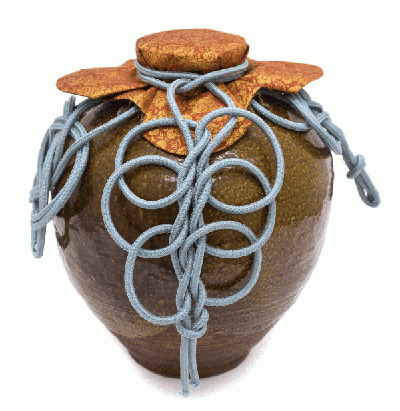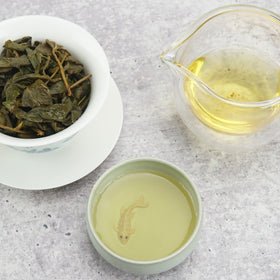
Chigusa
We have named our upcoming presentation on Japanese tea ceremony, Chigusa. The event takes place this Sunday 01/22 at Leaf Tea Bar. If you are curious what Chigusa means, it is but a name of a clay jar that was used to store tea in Japan. No, not a type of a jar, but a jar that dates back to the 14th Century and was named Chigusa by tea men who had fallen in love with it. Today, the jar sits in the Smithsonian Institution.

Why would we name an event after a 700 year old tea jar?
The story of Chigusa embodies the quintessential Chanoyu (as Japanese tea ceremony is called) approach where the ordinary, or even the imperfect, gets transformed to an object of beauty and reverence. This unique approach we think is valuable, especially in our times when conflict and ugliness threaten to overwhelm. Chigusa was just an ordinary vessel - not necessarily meant to store tea - that rose through the ranks to become a revered object in Japan. The jar was bought by the Freer Gallery of Art in 2009 for $662,500.
At a personal level, there were some ordinary yet special events over the summer that caused Chigusa to leave an imprint on us. I had bought the book, Chigusa and the Art of Tea without exactly being sure what it was about. While waiting to start reading the book, I had it displayed at our Leaf Tea Bar. Soon there after a lady came for tea. Turns out she was from Japan and her name was Chigusa. What was remarkable was that she did not know, until the moment she looked at that book, what Chigusa meant!

I then showed the book to Rie Maywar. Rie was born in Japan and started practicing Chanoyu when she was 15. She now holds a 3rd degree instructor licence from Urusanke school of tea, and she will be making the presentation on Chanoyu for us. Rie was very excited when I showed her the book. She suggested we call the event Chigusa. I now had to find out what Chigusa was all about.
In a literal sense Chigusa means "abundance of varieties." However, for the first 200 years of its existence not much was known about the jar This 16.37" high jar, with diameter of 14.40" at its largest, and 4.5 kg in weight, was constructed from coarse-textured stoneware clay and a glaze mix of wood ash and iron-bearing clay. It was like any of the hundreds of utilitarian vessels coming out of southern China kilns.

However, by 16th century the vessel had earned its name Chigusa, and a reputation that qualified it for special viewing by participants in chanoyu. To show their appreciation and reverence for a tea object tea men would confer upon it a proper name. Not all tea objects attained this privilege. An important 16th century document on chanoyu, The Records of Yamanoue no Soji ki listed 22 tea leaf storage jars by their names, owners and distinguishing features. Chigusa was one of them. By the 20th century only six of them were believed to be in existence.
The practice of according high value to relatively unremarkable clay jars marks a paradigm shift in tea aesthetics that was fostered by the Japanese tea ceremony. As chanoyu reached its creative heights it demanded "a fresh approach to connoisseurship...(and) took a positive view of irregularities and flaws in form and glaze," notes Louise Allison Cort in Chigusa and the Art of Tea.

This was also part of the Japanese wabi-sabi philosophy where beauty is described as "imperfect, impermanent and incomplete." As chanoyu evolved tea utensils moved away from the Chinese aesthetics with its pretty and perfect creations, to a more natural, rugged and rustic forms. The wabi-sabi tradition continues to inform Japanese tea pottery.

Chigusa was used to store tea leaf harvested during spring. The jar was opened in autumn after the leaves had a period of rest. The storage was meant to improve the quality of the tea. Leaves were taken out and then ground up in a stone mortar to make matcha, the powered tea. (This is a rare practice now with people preferring the more convenient approach of buying commercially manufactured matcha.)

Originally, tea storage jars, or chatsobu, were not displayed during chanoyu. But later as aesthetics changed the jars were "embellished" with covers and cords and displayed prominently. The ownership of Chigusa passed through several families that included artists, tea men and shoguns. Chigusa's pedigree is confirmed by the boxes and the documents it came in and with when Freer Gallery acquired the jar. The innermost storage box dates to the Edo period (1615-1868). It also contained several documents of ownership-transfer, list of accoutrement, several letters one of which is from the greatest 16th century Japanese tea master, Sen No Rikyu.
The story of Chigusa is one of "rags-to-riches" writes Louise Cort. Or more correctly it is a story about how men found "riches in rags" thanks to the Chanoyu approach.
Images credit http://asia.si.edu



Leave a comment